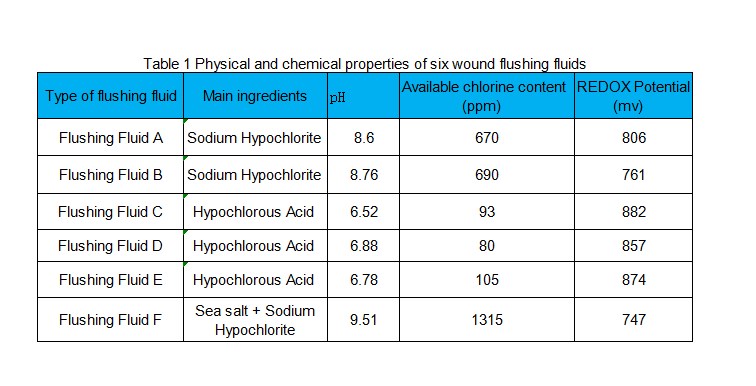Home Page / Applications / Why Must Hypochlorous Acid Be Used Instead Of Sodium Hypochlorite
Why must hypochlorous acid be used instead of sodium hypochlorite?

In clinical wound treatment, finding better antibacterial agents (disinfectants) is one of the focuses of doctors and the entire medical industry. Any antibacterial agent will be recognized and accepted by the industry and the market only if it has a more substantial bactericidal effect, weaker cytotoxicity, and less residual risk. Among them, the bactericidal effect is the core of the antibacterial agent (disinfectant), which is the primary concern of people. Still, at the same time, we cannot ignore the issue of cytotoxicity, which will directly affect whether the disinfectant can be used in the human body or not. Indirect contact with the human body.
The research methods
Regarding cytotoxicity, Professor Anna-Lena of Germany recently selected 6 kinds of new wound washes whose main components are sodium hypochlorite, hypochlorous acid, and medical sea salt as the experimental objects, using the XTT method (one of the common methods for cytotoxicity detection) ) were tested to evaluate the cytotoxicity of these chlorine-containing rinses by comparing the proliferation of human keratinocytes (HaCaT) and human skin fibroblasts (BJ).

https://academic.oup.com/jac/article/74/2/365/5156210
Research result
The study results found that the main components of the wound rinses C, D, and E were hypochlorous acid, which showed no cytotoxicity to human keratinocytes and skin fibroblasts after 15 minutes of treatment. The main component of rinsing solution A and rinsing solution B is sodium hypochlorite, and no cytotoxic effects were detected within 1 minute of treatment. Still, after 15 minutes of treatment, it was found that the production of human keratinocytes moderates cytotoxicity and strong cytotoxicity to skin fibroblasts. The main components of irrigant F were sea salt and sodium hypochlorite, which had the highest cytotoxicity, and produced moderate cytotoxicity to skin fibroblasts within 1 minute of treatment. This shows that the cytotoxicity of hypochlorous acid is far less than that of other chlorine-containing preparations.
Coincidentally, in oral research, there are also a large number of experimental research results echoing this view. Boyle's research team's investigation confirmed that low-concentration hypochlorous acid treatment does not affect the proliferation of human oral epithelial tissue cells; Fujita's research team's experimental results showed that hypochlorous acid had no significant effect on the proliferation of gingival fibroblasts and KB cells; Capital Medical Department The team of Dr. Jing Su of the University also used hypochlorous acid to treat monolayer keratinized epithelial cells (TR146 cells), and found that the relative proliferation rate of cells after treatment was close to 100%, and the grade was non-cytotoxic.
Analysis conclusion
Through the collation of these preliminary experimental results and clinical application, it is found that hypochlorous acid has good application prospects in cytotoxicity:
1) First of all, considering the inhibitory effect of protein on hypochlorous acid, pure hypochlorous acid at a concentration of less than 300ppm is safe for wound cleaning, which is comparable to hypochlorous acid produced by the human body in acute inflammatory reactions and will not cause significant cytotoxicity to the human body.
2) At the same time, the higher the purity of hypochlorous acid, the less toxic it is to cells. Studies have shown that even five ppm of hypochlorite can interfere with cellular activity.
3) In addition, pH is also a significant factor in inducing cytotoxicity, and higher or lower pH is detrimental to the epidermal cell layer. In the process of wound healing, the pH of the wound will gradually decrease from 9 to below 7. During this process, the toxicity of bacterial end products (such as ammonia) will be inhibited, the enzymatic activity will increase, and the ability to destroy abnormal collagen will be enhanced. To accelerate angiogenesis. Therefore, the cytotoxicity of hypochlorous acid is the weakest in the pH range of 5.5~7.
On the whole, hypochlorous acid is an efficient and safe disinfectant preparation. As long as it is used in a normal range, it has a good disinfection effect and almost no cytotoxicity.
